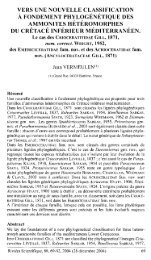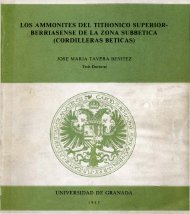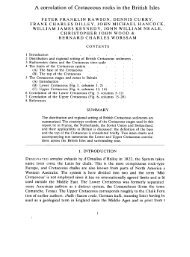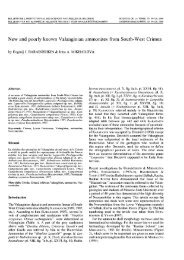thiolliericrinid crinoids from the lower cretaceous of crimea
thiolliericrinid crinoids from the lower cretaceous of crimea
thiolliericrinid crinoids from the lower cretaceous of crimea
Create successful ePaper yourself
Turn your PDF publications into a flip-book with our unique Google optimized e-Paper software.
1975 — Thiolliericrinus Étallon : Hess, p .69.1978a — Thiolliericrinus Étallon : Roux, p. 234.1978b — Thiolliericrinus Étallon : Roux, p. A 20.1978c — Thiolliericrinus Étallon : Rasmussen, p.879.Type species :Humberticrinus favieri De Loriol ex Étallo n,1879.Diagnosis :Radiais with ei<strong>the</strong>r high or low free external surface.Basais are visible or not on <strong>the</strong> calyx surface.The cirrus sockets have different size and are placedirregularly. Some <strong>of</strong> <strong>the</strong> sockets are turned into structurelessfossae. The centrodorsal is conical, high orlow. The stem facet is small, flat or convex.Six species : T. arzierensis De Loriol, T. favieri(De Loriol ex Étallon), T. ribeiroi De l o r io l, T.belbekensis nov. sp., T. elongatus nov. sp., T. torosusnov. sp.Upper Jurassic (Oxfordian) - Lower Cretaceous(Valanginian) ; Portugal, France, Switzerland, Crimea.Thiolliericrinus arzierensis De Lo rio l, 1889 (p. 560)(= Antedon valdensis De Loriol 1879, p. 266 exparte : pi. 20, fig. 20, non fig. 19, 32, 33 = Solanocrinitesvaldensis) (Thiolliericrinus arzierensis : Gislén1924, p. 187 ; Rasmussen 1961, p. 212, pi. 35, fig.13 ; Hess 1975, p. 69, pi. 20, fig. 13). Valanginian ;Arzier (Vaud), Switzerland (fig. 3 C).Thiolliericrinus favieri (De L o r io l ex É t a llo n ,1879, p. 194, pi. 18, fig. 8-10 sub Thiolliericrinusflexuosus (= Thiolliericrinus sp. É t a llo n , 1857, p.301 ; = Thiolliericrinus flexuosus : Étallon 1859, p.445 ; Étallon 1862, p. 222, 237 ; De Loriol 1889, p.553 ex parte, pi. 229, fig. 2,4,5,7,8, non fig. 3,6 =Loriolicrinus sp ; Kirk 1912, p. 75, pi. 5, fig. 4 ; Rasmussen1978c, p. 879, fig. 588-2b,c,d non fig. 588-2a= Loriolicrinus sp. ; = Humberticrinus favieriÉ ta llo n : De Loriol 1879, p. 195 ; 1889, p. 556 ;'Thiolliericrinus favieri : Gislén 1924, p. 187 ; Roux1978b, p. A 20 ; non Thiolliericrinus favieri : Ubaghs1953, p. 718, fig. 104 ; 1978, p. 72, fig. 52-2 = Thiolliericrinussp. Ba<strong>the</strong>r 1900, p. 195, fig. 117-1). Kimmeridgian(Dicératien) . Valfin (Jura), France (fig. 3D).Thiolliericrinus ribeiroi De lo r io l, 1880 (pi. 11,fig. 1, fig. 3-11) (= Thiolliericrinus ch<strong>of</strong>fati Deloriol, 1889, p. 547, 556, nomen provisorium)(Thiolliericrinus ribeiroi : Carpenter 1881b, p. 377 ;De Loriol 1889, p. 557, 558, pi. 229, fig. 9 ; De Loriol1891, p. 165 ex parte, pi. 29, fig. 16, 18-22, non fig. 17= Burdigalocrinus lorioli ; Ba<strong>the</strong>r 1900, p. 195, fig.117-2 ; Jaekel 1918, p. 71, fig. 63 ; Gislén 1924, p.187 ; Ubaghs 1953, p. 718, fig. 103 ; 1978, p. 72, fig.52-1 ; Rasmussen 1978c, p. 880, fig. 588-2 g-h ; Roux1978a, p. 234). Lusitanian ; Engenheiro (Ribatejo),Portugal (fig. 3 E).Thiolliericrinus belbekensis nov. sp.D e r iv a t io n o m i n i s :fig. 4 A ,В ; 5 A-FThe name <strong>of</strong> <strong>the</strong> species comes <strong>from</strong> <strong>the</strong> type locality.H o l o t y p e :CK-85-1 (fig. 5 A) ; Leningrad Mining Institute.T y p e l o c a l it y :Kuibyshevo, Belbek Valley, Crimea.T y p e l e v e l :Upper Berriasian.D e s c r i p t i o n :The calyx is low, subcylindrical with <strong>the</strong> rounded =pentangular outline. The basais are not visible on <strong>the</strong>external calyx surface. But small triangular plates areobserved in some specimens in some interradia.Basais are rod-like, narrowed towards <strong>the</strong> outer marginand risen abruptly inside <strong>the</strong> calyx. The externalsurface <strong>of</strong> <strong>the</strong> radiais is low, vertical and slightly convex.It is covered with coarse granules. The radialfacets are wide. The furrow-like depression is placedunder each radial facet on <strong>the</strong> external radial face.The calyx cavity is broad and shallow. 10 furrows leanbetween <strong>the</strong> radiais and are fully pronounced on <strong>the</strong>irmiddle part. The inner radial surface is covered withweak furrows. The basais are visible on <strong>the</strong> bottom <strong>of</strong><strong>the</strong> calyx cavity only in eroded specimens, but arecommonly covered with a porous calcitic plug. Theprimaxillary has a strongly convex uneven externalsurface. Its <strong>lower</strong> facet is muscular. The second axillaryis very asymmetric with <strong>the</strong> muscular <strong>lower</strong> facetand with a strongly convex granulated external
















